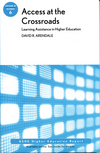Mission Differentiation: Code Language for Cutting Programs at Schools No Longer Wanted
T he following is excerpted from my recent book, Access at the crossroads: Learning assistance in higher education (2010, Jossey Bass). Several of my recent blog posts have been about the elimination of developmetnal-level courses in Ohio. I also posted the message to the LRNASST email listserv and received reports from half a dozen other states that had previously enacted the same policy. I was disappointed to read that some people welcomed the decision since the students were better served at the two-year instiutions. I don't disagree about that result (as diappointing as that is). The issue I am concerned about is what happens when four-year institutions engage in "mission differentiation" and discontinue services and programs that had previously provided for more than 100 years. The following is my analysis of the practice and supported by research studies of others concerning the dramatic and negative outcomes as a result. -- David Arendale
he following is excerpted from my recent book, Access at the crossroads: Learning assistance in higher education (2010, Jossey Bass). Several of my recent blog posts have been about the elimination of developmetnal-level courses in Ohio. I also posted the message to the LRNASST email listserv and received reports from half a dozen other states that had previously enacted the same policy. I was disappointed to read that some people welcomed the decision since the students were better served at the two-year instiutions. I don't disagree about that result (as diappointing as that is). The issue I am concerned about is what happens when four-year institutions engage in "mission differentiation" and discontinue services and programs that had previously provided for more than 100 years. The following is my analysis of the practice and supported by research studies of others concerning the dramatic and negative outcomes as a result. -- David Arendale
Impact of Institutional Mission Differentiation on Learning Assistance
Economic challenges since the 1970s, especially among public institutions, have intensified. Land-grant institutions debate how to balance their historic egalitarian mission serving all state residents while curtailing programs and raising admission standards. Institutional leaders increasingly employ institutional “mission differentiation” to reign in costs and focus resources on the institution (Slaughter and Rhoades, 2004). Mission differentiation recognizes institutions with special programmatic offerings and targeted student populations. Selective college admission policies lead some to question the need for comprehensive learning assistance services, especially developmental courses.
Preliminary analysis of mission differentiation reveals unannounced and unanticipated outcomes for learning assistance (Bastedo and Gumport, 2003; Gumport and Bastedo, 2001; Slaughter and Rhoades, 2004). Analysis of learning assistance policy in Massachusetts and New York confirmed that mission differentiation led institutions to terminate academic programs, eliminate remedial or developmental courses, and promote honors colleges. The result is stratification of academic program opportunity in the state. Prestigious and high-demand academic programs were offered at fewer institutions than before. For students, stratification encouraged higher admissions standards at upper-tier institutions. As a result, students had fewer choices for postsecondary education (Bastedo and Gumport, 2003; Gumport and Bastedo, 2001; Slaughter and Rhoades, 2004).
Another result was curtailment of developmental courses at upper-tier institutions in the state system (Bastedo and Gumport, 2003; Gumport and Bastedo, 2001). Developmental courses are often a key ingredient in providing access and success for historically underrepresented students. Bastedo and Gumport (2003) concluded that more intense analysis is warranted before systemic changes occur to avoid or at least predict major changes in the stratification of students’ opportunity to attend postsecondary education and the student support systems needed for their success.
As more historically underrepresented students from diverse racial and socioeconomic backgrounds seek admission, important learning assistance infrastructures are dismantled (Bastedo and Gumport, 2003). Mission differentiation assumes incorrectly that college aspirants are more academically prepared, and institutional leaders therefore conclude that developmental credit courses and other traditional learning assistance activities are not needed. Increasingly, public four-year institutions curtail or eliminate developmental courses with the expectation that students needing such instruction easily access them at a community college (Bastedo and Gumport, 2003; Gumport and Bastedo, 2001; Slaughter and Rhoades, 2004). This option requires a local community college. Most students do not have the financial resources or time to commute long distances for such classes. These students often are financially disadvantaged and possess little free time. They cannot commute to multiple institutions for courses while maintaining a job (or two) to pay for college and support a family. Based on a national dataset, students who attend multiple institutions are less likely to graduate from college than those who begin at the intended degree-awarding institution (Adelman, 2006).
Mission differentiation raises a new set of questions and conflicts in postsecondary education (McPherson and Schapiro, 1999). Access to higher education shifts to access to what form of education and under what conditions. Differentiation among institutions increases stratification in society (Anderson, Daugherty, and Corrigan, 2005).
- Bastedo, M. N., and Gumport, P. J. (2003). Access to what? Mission differentiation and academic stratification in U.S. public higher education. Higher Education, 46(3), 341–359.
- Gumport, P. J., and Bastedo, M. N. (2001). Academic stratification and endemic conflict: Remedial education policy at CUNY. Review of Higher Education, 24(4), 333–349.
- Slaughter, S., and Rhoades, G. (2004). Academic capitalism and the new economy: Markets, state, and higher education. Baltimore: Johns Hopkins University Press. Soliday, M. (2002). The politics of remediation: Institutional and student needs in higher education. Pittsburgh: University of Pittsburgh Press.
